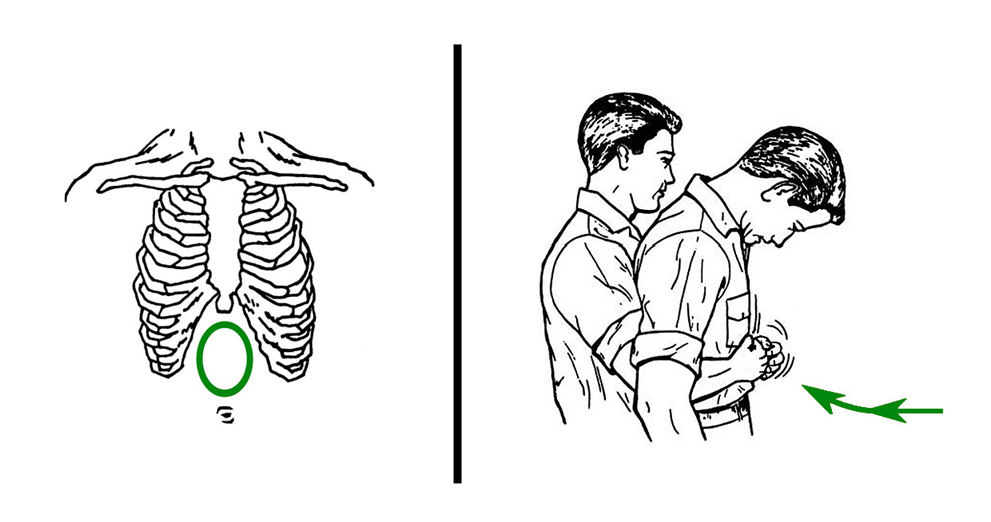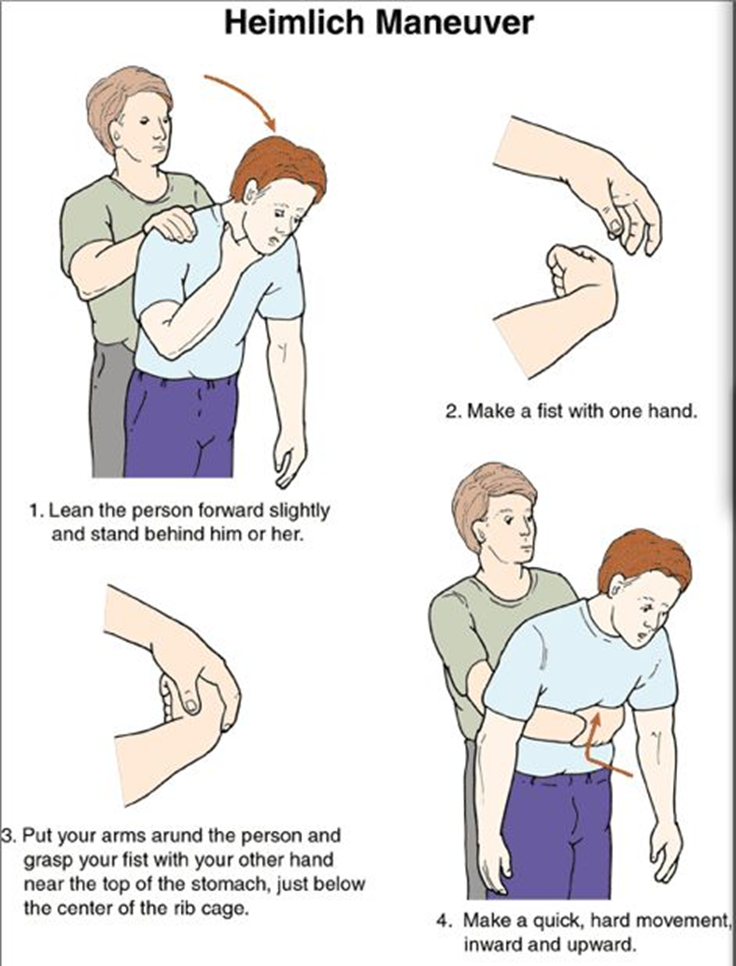A nurse is caring for a client who develops an airway obstruction from a foreign body but remains conscious. Which of the following actions should the nurse take first?
Perform a blind finger sweep.
Turn the client to the side.
Insert an oral airway.
Administer the abdominal thrust maneuver.
The Correct Answer is D
Choice A reason: Perform a Blind Finger Sweep
Performing a blind finger sweep is not recommended because it can push the foreign object further into the airway, making the obstruction worse. This method is only advised if the object is clearly visible and can be safely removed without causing further harm.
Choice B reason: Turn the Client to the Side
Turning the client to the side can be helpful in certain situations, such as when the client is unconscious or at risk of vomiting. However, in the case of a conscious client with a foreign body airway obstruction, this action does not directly address the obstruction and is not the first priority.
Choice C reason: Insert an Oral Airway
Inserting an oral airway is typically used to maintain an open airway in an unconscious patient who cannot maintain their own airway. For a conscious client with a foreign body obstruction, this action is not appropriate and could cause further complications.
Choice D reason: Administer the Abdominal Thrust Maneuver
Administering the abdominal thrust maneuver (also known as the Heimlich maneuver) is the recommended first action for a conscious client with a foreign body airway obstruction. This technique involves standing behind the client, placing a fist just above their navel, and delivering quick, upward thrusts to expel the foreign object. This method is effective in creating an artificial cough that can dislodge the obstruction.

Nursing Test Bank
Naxlex Comprehensive Predictor Exams
Related Questions
Correct Answer is A
Explanation
Choice A reason:
The Heimlich maneuver, also known as abdominal thrusts, is the recommended first aid technique for a conscious person who is choking. This maneuver helps to expel the object blocking the airway by using the air remaining in the lungs to force it out. The nurse should stand behind the person, place their arms around the person’s waist, make a fist with one hand, and place it just above the navel. The other hand should grasp the fist, and quick, upward thrusts should be performed until the object is expelled.

Choice B reason:
Slapping the client on the back several times is not the recommended first action for a conscious adult who is choking. While back blows can be effective, they are typically used in combination with abdominal thrusts and are more commonly recommended for infants. For adults, the Heimlich maneuver is preferred as the initial response.
Choice C reason:
Assisting the client to the floor and beginning mouth-to-mouth resuscitation is not appropriate for a conscious person who is choking. Mouth-to-mouth resuscitation, or rescue breathing, is used when a person is not breathing and is unresponsive. In this scenario, the client is conscious but unable to speak, indicating a blocked airway that requires the Heimlich maneuver.
Choice D reason:
Observing the client before taking further action is not advisable in a choking emergency. Immediate intervention is crucial to prevent the situation from worsening. If the person is unable to speak, cough, or breathe, the Heimlich maneuver should be performed without delay.
Correct Answer is A
Explanation
Choice A reason: Hemorrhage
Hemorrhage is a significant and immediate postoperative complication following a transurethral resection of the prostate (TURP). This procedure involves removing part of the prostate gland, which can lead to bleeding. Monitoring for signs of hemorrhage, such as a significant drop in blood pressure, increased heart rate, and visible blood in the urine, is crucial. Early detection and intervention are essential to manage bleeding and prevent severe complications. Hemorrhage can lead to hypovolemic shock if not addressed promptly, making it the priority complication to monitor for.
Choice B reason: Infection
Infection is a common postoperative complication, but it typically develops a few days after surgery rather than immediately. Signs of infection include fever, chills, and increased white blood cell count. While it is important to monitor for infection, it is not the immediate priority compared to hemorrhage. Preventive measures, such as maintaining sterile techniques and administering prophylactic antibiotics, can help reduce the risk of infection.
Choice C reason: Urinary retention
Urinary retention can occur after TURP due to swelling or blood clots obstructing the urethra. This condition can cause discomfort and increase the risk of bladder damage. Monitoring for urinary retention involves assessing the client’s ability to void and checking for bladder distention. While it is an important complication to monitor, it is not as immediately life-threatening as hemorrhage.
Choice D reason: Pain
Pain is a common postoperative symptom and should be managed effectively to ensure the client’s comfort and recovery. However, pain management is typically addressed through prescribed analgesics and is not considered a life-threatening complication. Monitoring for pain and providing appropriate pain relief are essential aspects of postoperative care, but they do not take precedence over monitoring for hemorrhage.
Whether you are a student looking to ace your exams or a practicing nurse seeking to enhance your expertise , our nursing education contents will empower you with the confidence and competence to make a difference in the lives of patients and become a respected leader in the healthcare field.
Visit Naxlex, invest in your future and unlock endless possibilities with our unparalleled nursing education contents today
Report Wrong Answer on the Current Question
Do you disagree with the answer? If yes, what is your expected answer? Explain.
Kindly be descriptive with the issue you are facing.
